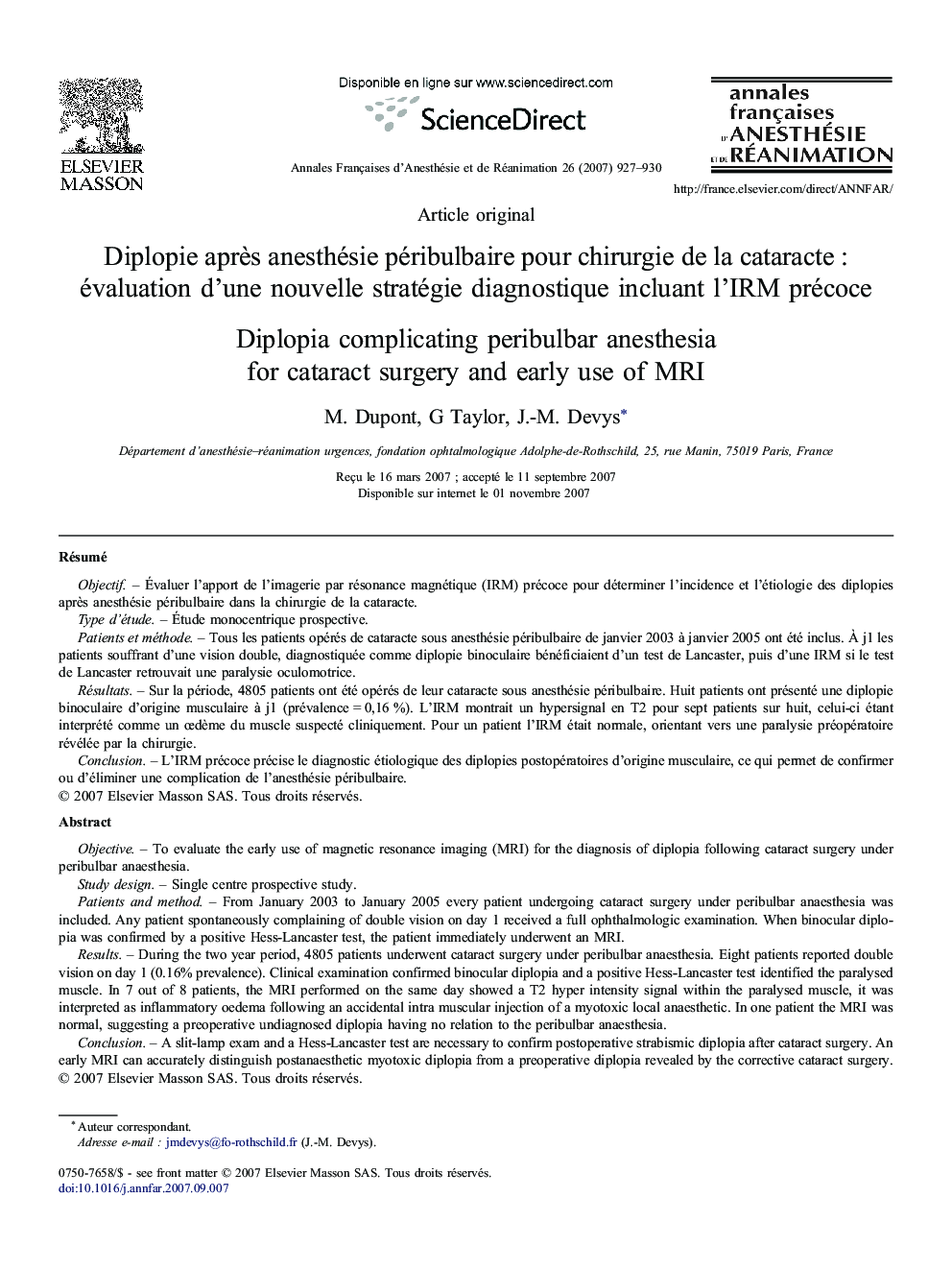| کد مقاله | کد نشریه | سال انتشار | مقاله انگلیسی | نسخه تمام متن |
|---|---|---|---|---|
| 2747578 | 1148918 | 2007 | 4 صفحه PDF | دانلود رایگان |

RésuméObjectifÉvaluer l'apport de l'imagerie par résonance magnétique (IRM) précoce pour déterminer l'incidence et l'étiologie des diplopies après anesthésie péribulbaire dans la chirurgie de la cataracte.Type d'étudeÉtude monocentrique prospective.Patients et méthodeTous les patients opérés de cataracte sous anesthésie péribulbaire de janvier 2003 à janvier 2005 ont été inclus. À j1 les patients souffrant d'une vision double, diagnostiquée comme diplopie binoculaire bénéficiaient d'un test de Lancaster, puis d'une IRM si le test de Lancaster retrouvait une paralysie oculomotrice.RésultatsSur la période, 4805 patients ont été opérés de leur cataracte sous anesthésie péribulbaire. Huit patients ont présenté une diplopie binoculaire d'origine musculaire à j1 (prévalence = 0,16 %). L'IRM montrait un hypersignal en T2 pour sept patients sur huit, celui-ci étant interprété comme un œdème du muscle suspecté cliniquement. Pour un patient l'IRM était normale, orientant vers une paralysie préopératoire révélée par la chirurgie.ConclusionL'IRM précoce précise le diagnostic étiologique des diplopies postopératoires d'origine musculaire, ce qui permet de confirmer ou d'éliminer une complication de l'anesthésie péribulbaire.
ObjectiveTo evaluate the early use of magnetic resonance imaging (MRI) for the diagnosis of diplopia following cataract surgery under peribulbar anaesthesia.Study designSingle centre prospective study.Patients and methodFrom January 2003 to January 2005 every patient undergoing cataract surgery under peribulbar anaesthesia was included. Any patient spontaneously complaining of double vision on day 1 received a full ophthalmologic examination. When binocular diplopia was confirmed by a positive Hess-Lancaster test, the patient immediately underwent an MRI.ResultsDuring the two year period, 4805 patients underwent cataract surgery under peribulbar anaesthesia. Eight patients reported double vision on day 1 (0.16% prevalence). Clinical examination confirmed binocular diplopia and a positive Hess-Lancaster test identified the paralysed muscle. In 7 out of 8 patients, the MRI performed on the same day showed a T2 hyper intensity signal within the paralysed muscle, it was interpreted as inflammatory oedema following an accidental intra muscular injection of a myotoxic local anaesthetic. In one patient the MRI was normal, suggesting a preoperative undiagnosed diplopia having no relation to the peribulbar anaesthesia.ConclusionA slit-lamp exam and a Hess-Lancaster test are necessary to confirm postoperative strabismic diplopia after cataract surgery. An early MRI can accurately distinguish postanaesthetic myotoxic diplopia from a preoperative diplopia revealed by the corrective cataract surgery.
Journal: Annales Françaises d'Anesthésie et de Réanimation - Volume 26, Issue 11, November 2007, Pages 927–930